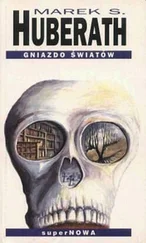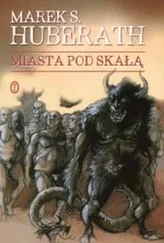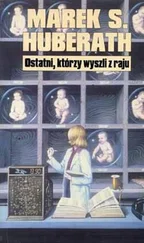“Do you think it will agree to stay with us? Cats are territorial animals,” said Hobeth.
“This could be its territory.”
“But it has such stupid brows,” laughed Hobeth. “Seven hairs on each… and completely gray…”
“You’re getting senile,” said Ozza, but glanced fondly at the cat from her driver’s seat.
“What should we name it?” Nothing could spoil Hobeth’s good mood.
There was a moment of silence.
“Roan,” said Ozza.
“Good, Roan lives again. But won’t he be angry with us for that?” she asked, turning to one of the photographs stuck in a slit between two metal sheets of the chassis.
“The cat even looks like him,” said Ozza with a grin. “He’s gone to sleep, and we must prepare his meal.”
“You haven’t opened Nest of Worlds since yesterday,” Hobeth said.
Ozza shrugged. “Linda ran off with Zekhe before Jack could do anything.”
“How could she run off? Jack killed them both.”
“Jack overlooked the pictures of Linda the first time he went through the roll of film. Meanwhile the couple figured out what was up and left before the film dried. Gail might put Jack on their trail. They have to show their identity papers in their new place, after all. I’m not looking in the book until Zekhe has had time to think up something.”
“Zekhe will get what’s coming to him. Linda won’t stop picking up strangers.”
“You think? I’ve grown to like her.”
Has Ra Mahleiné found the answer? Does my reading stop the epidemic of deaths? I leave my surroundings, reading, I don’t think of other things. Perhaps the correlation of death disappears then, and life returns to normal.
He smiled at himself. Medved hadn’t called in a while. Perhaps there was no reason for him to call. Perhaps Ra Mahleiné’s illness too had stopped.
And Zef, what conclusions had he reached?
Gavein removed the first index card from the pages of the book. It was covered with close, tiny writing, in a precise, slanted hand, and included formulas of some kind.
I’m establishing a hierarchy of the worlds: the more nested the book, the higher the degree of nesting. Obvious, but one has to start somewhere. As the degree of nesting increases, the number of Lands increases; the time spent in a given Land decreases; the number of Significant Names increases, as well as the number of versions of Nest of Worlds . The structure of the versions resembles the branches of a tree: the next degree of nesting is a new branch. Two versions of Nest of Worlds , it’s exactly like two trees.
With the degree of nesting, the physics of the nested world changes. The Lands in the world of Gary and the Bolyas are surrounded by a desert in which there are separate threads of common time—in each path taken, the retardation of time is different. In Jaspers’s world, and in worlds more deeply nested, the divergences are so marked that no common time can be determined between any two Lands.
That’s a qualitative analysis. Now let’s look at the numbers.
I calibrate: Let the world of Gary, Daphne, and the Bolyas be 1, the world of Jaspers 2, the world of Ozza and Hobeth 3, the world of Linda and Jack 4.
Comparing the number of the world with the number of its Lands: world 1 has nine, world 2 sixteen, world 3 twenty-five, and world 4 thirty-six. Do you see, Dave, what a simple formula connects them? [Zef often addressed Gavein in his notes.] The number of Lands = (n + 2) 2, where n is the number of the world. Pretty and elegant.
Gavein looked at the formula with a frown. He didn’t care for symbolic notation. He had difficulty following that kind of thinking, though he understood it.
I tried comparing the times of stay in each of the nested worlds. It’s as follows: 15 5/9 years, 8 3/4 years, 5 6/10 years for worlds 1, 2, and 3, respectively. In days, that comes to 5,677, 3,194, 2,044. I see no pattern. Not yet, that is!
The number of nested worlds must be finite. Otherwise, even if each version contained only one letter, Nest of Worlds would have an infinite length—and I can hold this book in my hand, after all. I can lift the back cover and look at the last page, though I don’t understand what I read there. A simple proof, no, Dave?
“It isn’t that easy. You’re in error there, I think, my friend… The book expands, like an accordion.” He remembered what Wilcox had said, how Wilcox had spent whole days on one page. And the stricken look in the man’s eyes. Gavein suspected that it was impossible to read the entire contents of Nest of Worlds . There was a “microscope effect” in operation: the more carefully you read and the more the reading absorbed you, the more detailed the description grew. New facts emerged, things that hadn’t been there before. Whenever you came upon a nested world that interested you particularly, this happened.
If Zef came to the conclusion he came to, he must have been a fairly superficial reader of the worlds. Gavein had no problem with there being an infinite number of nested worlds in the book. No reader would visit more than a handful of them, in any case.
Another, more intuitive explanation: a reader in a nested world could learn more than Gavein about a world that was near that reader. Ozza could read in great length about Linda and Jack, while Gavein’s view of them was at best fragmentary.
Turning the pages of the book, he found another scrap of paper with Zef’s notes. It had been crumpled, then smoothed out, and was covered with writing. Zef was going to throw it out, Gavein thought, but changed his mind…
The writing was smeared, maybe because (Gavein thought with a smile) Zef was left-handed. Gavein used to tease him about that, but not in Ra Mahleiné’s presence, because she was left-handed too, though her writing was never smeared.
The number of nested worlds must be finite for another reason [Zef wrote]. In each Land there is more or less the same number of people, since they are born at pretty much the same rate. In a world 173,204, for example, there would be thirty billion Lands, so you would have five or ten Lands to every person. Since a man and woman would meet once in only fifty to two hundred Lands, it is clear that the population of such a world would die out.
In addition, giving birth takes about an hour, so there could not exist a world of so high a degree of nestedness that an inhabitant would have less than that time in a Land.
These birth arguments were better.
Every evening Lepko sat at the head of Jaspers’s bed, waiting for Crooks to fall asleep. He didn’t want to provoke Crooks with bits of straw falling from the mattress. Jaspers, unable to read while Lepko sat, began to ask him about principles of accounting, which in Darah were the same as in Taayh.
Soon Jaspers was promoted again and no longer had to stay by the conveyor belt. For hours he walked down production halls with a noter in his hands and recorded, added, transmitted. It was tedious, exacting work. Every hour he had to collect numbers that described current production and inventory, and these he input into the planning machine. In response he got a printout of production for the next hour. He corrected for the latest indicators received, adjusted the work schedule accordingly, and distributed the new orders.
Then he had fifteen to twenty minutes of free time to read the newspaper. He was barely able to run an eye over the data for food, clothes, shoes produced; the predictions for the goods that would be divided among the older and younger workers. And the cycle began again.
Читать дальше












